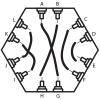I'm not really even sure what to call the help I need.... I'll do my best to explain.
I want to design hex tiles. Tsuro style, where the tile has connections that lead to other tiles (see attached photo). In the photo, I have each connection named A, B, C, etc.. to L. What I am wondering is, is there a mathematical, or Excel, way of generating all of the possible combinations using these connections? I could go through and draw out each and every one, but I'm worried I will duplicate one and not notice, or skip a lot of them.
In a perfect world, Excel would spit out a list of letters, which would give me a list of all possible connections. For the image attached, it would read "AG BH CF DE IK JL" or something along those lines. Basically telling me which two connections need to be connected.
Any and all help would be appreciated. Thanks!








Thanks for the replies. I had done something similar already, but seeing it written out your way definitely helped.
I assume there is no way to "automatically" create all of the possible combinations though. So, I'll just do it manually, and carefully.
Thanks again!